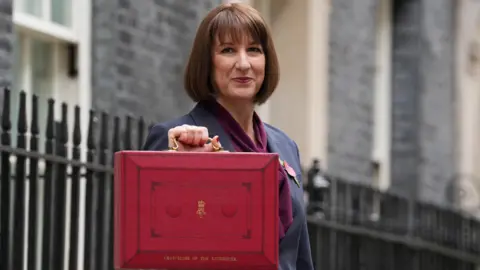Business
New Jersey’s AI data centers face new water usage bill

🔴 A single AI data center could consume 5 million gallons of water daily
🔴 New Jersey wants to make them report water consumption
🔴 Opponents say the measure is redundant, could hurt industry
A bill sitting on Gov. Phil Murphy’s desk requires new thirsty AI data centers to disclose how much water and electricity they use, but it’s getting pushback from New Jersey’s top business leaders.
The legislation (S4293/A5548) passed in the state legislature on June 30.
The reports to the state Board of Public Utilities would have to be made quarterly, according to Sen. Bob Smith, D-Middlesex, who chairs the Senate Environment and Energy Committee.
Smith said these “monsters” can use 3 million gallons of water just for cooling every day.
While environmentalist groups approve of keeping a close eye on these massive AI data centers that are driving up electricity costs throughout New Jersey, some business leaders are against the measure.
High-voltage transmission lines provide electricity to data centers
Why not track the resource consumption of AI data centers?
The New Jersey Business & Industry Association wants Gov. Murphy to veto the bill, which has reached his desk.
Ray Cantor, the NJBIA’s deputy chief of government affairs, says the bill is unnecessary; the state Department of Environmental Protection already handles water usage permits and the BPU tracks electricity usage.
According to the NJBIA, the bill is based on a “false narrative” that AI data centers harm the environment and the surrounding communities.
“This legislation sends the wrong message to our business community and unintentionally vilifies data centers and the great resources they provide,” Cantor said.
AI data centers can guzzle 5 million gallons of water per day
However, taking 5 million gallons daily from any water source will impact nearby homes and businesses, according to Doug O’Malley, the director of Environment New Jersey.
That’s between liquid cooling and the water consumed to generate the energy that powers them. Some AI data centers require 300 MW of electricity, which is equal to the output of a small modular nuclear reactor.
O’Malley says these facilities, which he calls water hogs, can only further strain on the state’s water supply.
“Imagine your typical community and suddenly you have an allocation of 5 million more gallons. That’s why we can’t just rely on what we have right now,” O’Malley said.
Report a correction 👈 | 👉 Contact our newsroom
These NJ school districts have full day pre-K
More New Jersey school districts than ever have free, full-day preschool programs — as of early 2025.
Gallery Credit: Erin Vogt
Here’s 40 great NJ coffee spots to visit
New Jerseyans have a strong crop of choices for a freshly roasted cup of coffee, around NJ. Here’s a roundup of 40 spots to get caffeinated — some of them different locations for the same NJ-born brand.
Gallery Credit: Erin Vogt
Business
Inside the Secretive World of America’s AI Data Centers

The explosion of AI across every industry has seen hundreds of water- and power-hungry server farms sprout up across the US.
Already, one-third of the world’s internet traffic flows through data centers in just one US state: Virginia.
However, until now, there has been no official record of the number of data centers in America, who owns them, or how much electricity they consume.
In an exclusive deep dive into the industry, Business Insider reporters cracked the code and, for the first time, revealed the true cost of the data warehouses feeding our growing appetite for cloud computing and AI.
We traveled to Virginia to meet people living in the shadow of 80-foot-high boxes that emit a constant drone, and to the drought-ridden state of Arizona, where some data centers are using as much as a million gallons of water a day to help cool their computer servers.
Business Insider also discovered that the power needs of data centers have forced some states to withdraw from their carbon emissions targets. Power companies are even looking to extend the life of coal and gas plants to help meet the unprecedented demand.
Click here to read our complete series of features on the US data center industry.
Take a look at Business Insider’s methodology for a full breakdown of how we conducted our research and compiled our map.
Business
When is the Budget and what might be in it?

Jennifer Clarke & Tom EspinerBBC News
 Reuters
ReutersThe Chancellor Rachel Reeves will set out plans for the economy when she delivers the Budget on 26 November.
There have been warnings that she will have to put up taxes or cut spending if she wants to stick to her own rules on government borrowing.
Before the 2024 general election, Labour promised not to increase income tax, National Insurance or VAT for working people.
What is the Budget?
In her Budget statement, the chancellor of the exchequer will outline the government’s plans for raising or lowering taxes.
It will also include big decisions about spending on health, schools, police and other public services.
The statement is made to MPs in the House of Commons.
Alongside the Budget, additional details about the measures and costs will be published by the Treasury, the government’s economic and finance ministry.
The independent Office for Budget Responsibility (OBR), which monitors government spending, will also publish an assessment of the health of the UK economy and a forecast of what it thinks will happen in the future.
What time is the Budget and what happens afterwards?
The Budget speech usually starts at about 12:30 UK time – after Prime Minister’s Questions – and lasts about an hour.
It will be broadcast live on the BBC iPlayer and on the BBC News website.
The Leader of the Opposition, Conservative MP Kemi Badenoch, will respond to the speech in the House of Commons.
MPs debate the measures for four days, before voting on them.
If approved by MPs, tax changes can come into effect immediately. However, the government must pass a finance bill to make them permanent.
What might be in the Budget?
There has been lots of speculation that Reeves might raise taxes in the Budget.
This is because she is expected to need to raise extra money to meet her self-imposed rules for government finances, called fiscal rules.
Reeves has two main rules, which she has said are “non-negotiable”:
- Not to borrow to fund day-to-day public spending by the end of this parliament
- To get government debt falling as a share of national income by the end of this parliament
However, in its last estimate in March, the OBR said the chancellor only had £10bn headroom to meet these rules, which it called a “very small margin”.
Since then the government has U-turned on planned benefit cuts that had aimed to save billions, while the cost of government borrowing has also increased.
Tax thresholds
There has been speculation that if the government wants to raise more tax without increasing income tax, VAT or National Insurance for working people, it could extend the current freeze on income tax thresholds, which is due to end in 2028.
Freezing the thresholds means that, over time as salaries rise, more people reach an income level at which they start paying tax or qualify for higher rates. This is often referred to as a “stealth tax”.
Property taxes
There have also been reports that property taxes will be reformed.
This could include replacing stamp duty – a tax buyers pay on properties above a certain value in England and Northern Ireland – with a property tax.
Landlords could have to pay more taxes, and council tax could be replaced.
One report suggested the government was considering taxing the money people make when they sell their main home in certain circumstances – this would mean changing the capital gains tax rules.
Isa reform
In July, the chancellor ruled out any immediate reform to cash Isas (Individual Savings Accounts). There had been speculation that she wanted to reduce the annual allowance to push people into investing in shares instead, to help boost economic growth.
It is possible that reform could still happen, but other measures to encourage people towards personal investment are considered more likely.
Pension changes
There is often speculation about possible changes to pension rules ahead of the Budget, such as the tax relief available to savers and the level of the tax-free lump sum which can be withdrawn.
However, previous chancellors who have been tempted to change to the higher rate tax relief on pension contributions have not done so. Cutting the relief would save the Treasury money, but may make pension savings less attractive.
Other taxes
The TUC, the umbrella group for trade unions in the UK, has called for higher taxes on online gaming companies and on banks’ profits.
How is the UK economy doing?
The Labour government has repeatedly said that boosting the economy is a key priority.
A growing economy usually means people spend more, extra jobs are created, more tax is paid and workers get better pay rises.
The latest figures show that growth in the UK economy has slowed in recent months. The economy was flat in July, after growing by 0.4% in June.
Looking at the longer term trend, the economy grew by 0.2% in the three months to July, down from the 0.3% growth seen in the three months to June, and from the 0.6% growth seen between March and May.
Meanwhile prices in the shops are still rising faster than wanted.
Inflation – the rate at which prices rise – was 3.8% in the year to July, which is above the Bank of England’s 2% target.
Despite this, in August the Bank cut its key interest rate to 4%, taking the cost of borrowing to the lowest level for more than two years.
The Bank moves interest rates to try to keep inflation on target, and cuts are less likely when price rises are above 2%.
However, the Bank cut rates because of concerns that the jobs market is weakening, with data showing job vacancies are continuing to fall and wage growth is slowing.
Lower interest rates can make loans, credit cards and some mortgages cheaper, but can also mean worse returns for savers.
Business
AI cloud surge: Oracle’s Nvidia moment? What to know about Larry Ellison co-founded firm’s sudden rise

On Wednesday, Oracle stunned Wall Street when its shares surged 36% in a single day, the company’s biggest one-day gain since 1992. The rise followed its announcement of a series of multibillion-dollar deals in artificial intelligence (AI) cloud infrastructure, including a landmark agreement with OpenAI. The rally was so dramatic that Oracle co-founder Larry Ellison briefly overtook Elon Musk as the world’s richest person before market corrections set in.The $300 billion OpenAI deal and moreAt the centre of the surge is Oracle’s $300 billion, five-year agreement with OpenAI, one of the largest cloud computing contracts ever signed. The company will provide computing resources and infrastructure to power OpenAI’s advanced models. Oracle has also struck deals with Nvidia, SoftBank, Meta, and xAI, signalling its transformation into a core provider of AI infrastructure.Backlog signals long-term growthCEO Safra Catz revealed that Oracle’s backlog of finalised contracts has reached $455 billion, four times higher than last year, and is expected to cross $500 billion soon. This backlog offers investors confidence in sustained long-term revenue, even as quarterly results sometimes fall short of projections, as reported by ET.Competing with cloud giantsOracle’s position in AI cloud computing now puts it in direct competition with Amazon Web Services and Microsoft Azure. The company expects revenue from its cloud infrastructure business to rise 77% to $18 billion this year, and reach $144 billion within four years, according to news agency AP.The billionaire shuffleThe surge in Oracle’s stock briefly added around $100 billion to Ellison’s wealth, pushing him past Elon Musk in Bloomberg’s billionaire rankings. Musk, whose fortune is closely tied to Tesla, regained the top spot later in the day. But as AP noted, the episode highlighted how AI-driven optimism is reshaping wealth dynamics among tech leaders.Why it matters for AIOracle’s resurgence positions it as a critical enabler of global AI adoption. By providing high-performance, reliable cloud infrastructure, the company is not just fuelling chatbot development but also supporting applications in robotics, pharmaceuticals, finance, and automation. Or as Ellison himself summed it up during an earnings call: “AI changes everything.”
-

 Business2 weeks ago
Business2 weeks agoThe Guardian view on Trump and the Fed: independence is no substitute for accountability | Editorial
-
Tools & Platforms1 month ago
Building Trust in Military AI Starts with Opening the Black Box – War on the Rocks
-

 Ethics & Policy2 months ago
Ethics & Policy2 months agoSDAIA Supports Saudi Arabia’s Leadership in Shaping Global AI Ethics, Policy, and Research – وكالة الأنباء السعودية
-

 Events & Conferences4 months ago
Events & Conferences4 months agoJourney to 1000 models: Scaling Instagram’s recommendation system
-

 Jobs & Careers2 months ago
Jobs & Careers2 months agoMumbai-based Perplexity Alternative Has 60k+ Users Without Funding
-

 Podcasts & Talks2 months ago
Podcasts & Talks2 months agoHappy 4th of July! 🎆 Made with Veo 3 in Gemini
-

 Education2 months ago
Education2 months agoMacron says UK and France have duty to tackle illegal migration ‘with humanity, solidarity and firmness’ – UK politics live | Politics
-

 Education2 months ago
Education2 months agoVEX Robotics launches AI-powered classroom robotics system
-

 Funding & Business2 months ago
Funding & Business2 months agoKayak and Expedia race to build AI travel agents that turn social posts into itineraries
-

 Podcasts & Talks2 months ago
Podcasts & Talks2 months agoOpenAI 🤝 @teamganassi

